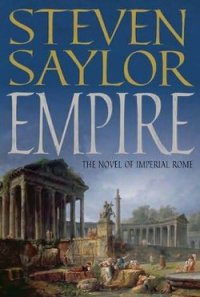Roma.The novel of ancient Rome - Saylor Steven (книги онлайн полные версии бесплатно .TXT) 📗
“Claudius wants the water to come here, to the place where we’re standing. The natural way to do it-to let the water follow the lay of the land and run downhill-would mean digging a channel straight down the spine of the horseracing track in the Circus Maximus. That would be too disruptive. Instead, Claudius wants the water to make a detour around the Circus Maximus. To accomplish that, we’re tunneling through the Aventine. The channel disappears into one side of the hill and will come out the other, right here. Amazing, no? But that’s still not the most impressive part. Follow me.”
They walked along the foot of the Aventine, crossing the open area to the south of the racing track. As they approached the city wall and the Capena Gate, Claudius’s novel solution for transporting the water loomed before them. To bridge the space between the high ground to the left of the gate and the high ground to the right, a channel was being built atop a series of arches constructed of brick and mortar. The road leading to the gate ran directly under one of these arches.
“To bring the water to Roma, Claudius will not only make it run underground-he’ll make it flow above our heads!” said Albinius. “This elevated part of the aqueduct runs for only a few hundred feet, out of a total distance of many miles. But it’s a brilliant solution-a river in the sky! There’s no reason this kind of construction can’t be repeated elsewhere, and no reason that such an elevated aqueduct can’t be built on an even larger scale, running mile after mile. Water can now be carried from any high point to any low point. All that’s required is to dig and tunnel and, where necessary, to run the channel over a series of arches, as we’ve done here. Since the beginning of the world, men have had to build cities where there was adequate water. Now a city can be built anywhere men wish, and the water can be brought to them. Such a possibility never existed before. The aqueduct will change not just Roma, but the whole world!”
The foreman’s enthusiasm was contagious, and Kaeso was impressed. He would have liked to spend the rest of the day at the man’s side, but, following Claudius’s instructions, he took his leave of Albinius.
Walking under the immense arch of the aqueduct, Kaeso passed though the Capena Gate and beyond the city walls. A brisk walk brought him to the censor’s other great construction project.
The site swarmed with workers busily digging, mixing mortar, and pushing barrows filled with gravel. Kaeso asked for the foreman, a man named Decius, and was taken to the biggest, brawniest man in sight.
“So, you’re here to learn about road building, are you?” said Decius. “Well, I’ve been at it all my life. Learned a thing or two in my forty-odd years. But, thanks to Appius Claudius, this is the first time I’ve ever seen a road planned ahead of time with so much care and precision. The whole course has been laid out, all the proper materials have been acquired, and the best team of workers in Roma has been assembled-never mind that the boys working on the aqueduct might wish to dispute that claim! This is going to be a job we can all be proud of. Your descendents a thousand years from now will walk on this road and say, ‘By Jupiter, what an outstanding job old Appius Claudius and his boys did when they laid down this road!’”
“This road will still be here a thousand years from now?”
“It most certainly will!”
Kaeso assumed the big man was exaggerating, but as Decius took him through the steps of laying down the road, he began to think the claim might have some merit.
“Your first roads were hardly more than footpaths,” said Decius, “beaten into the ground by so many men passing by-or by animals, since they make trails, too, and can usually figure out the best way to get over a pass or around a rough spot. When men started using wagons, the wheels wore ruts in the ground, and that made wider roads. Finally, some unknown genius decided it was time to make a road to fit the purpose, instead of just letting it come about on its own, and so the art of road building was born.
“The road we’re building follows a very old trail that’s been here for centuries; Appius Claudius says it dates back to the days of the old salt traders and metal traders, before Roma existed. Here you see some workers performing the first step in the process. See how they’re digging two shallow trenches parallel to each other? The trenches mark the breadth of the road. This road is fifteen feet wide, the sum of three men lying head to toe. Roman men, that is; it takes only two and a half Gauls to cover that width. They say a Gaul cut in half is the best kind, especially if it’s the half without a head!”
Decius laughed heartily at his own joke, and slapped Kaeso on the back as if he could jar him into doing the same. “Now, if you’ll follow me, up ahead you can see that they’ve moved on to the second stage. They’ve dug out the loose earth between the trenches, and excavated down until they’ve reached a solid foundation for the materials to rest on. How far down you have to dig depends on the terrain. Sometimes, if the ground’s swampy or the soil’s peculiar, you have to drive piles into the earth. Fortunately, that’s not the case here. A strong digger can reach solid roadbed without breaking his back. These fellows hardly even break a sweat. Isn’t that right, men?”
The diggers looked up at Decius and grinned. Kaeso could see that they liked the foreman.
“Keep walking. I’ll show you the next stage. See there, up ahead, those big piles of stones? Those are for laying the first course of the road. These stones have been sorted for size; these are what we call hand-sized, no larger and no smaller than will fit in a man’s hand. They make up the first stratum. On top of those, we lay down a mass of broken stones about nine inches deep, rammed down hard and cemented with lime-that’s called rubble-work. Above that, we lay the road-core, about half a foot deep, which is made up of bits and pieces of bricks and pottery, smaller bits than the stones in the rubble-work, and cemented with lime. You can see a section where the core’s been finished, up ahead.”
“It’s a bit higher in the middle than at the edges, isn’t it?” said Kaeso.
“Very observant. We do that on purpose, to let the water run off. For now, to finish the road, we’re laying down a layer of gravel. That’s usually the end of the job. But on this project, the gravel layer is to be only temporary. As time and money permit, the plan is to scrape away the gravel and lay down blocks of the hardest stone we can find. Around Roma, that usually means basaltic lava. The stones aren’t uniform, like bricks; they’re broken and cut into all sorts of random shapes-polygonal, we call them-but skilled workmen can pick and choose among those stones and fit them together until the surface is so perfectly even and smooth, you’d be hard-pressed to find the tiniest gap, even with your fingertip. I’ve seen walls built that way, and there’s no reason it can’t be done on a road, as well. Up ahead, we’ve completed a small section of the road with a finished stone layer, just as a showpiece for now. Here it is. Have a look. Walk on it. Jump on it! Stoop down and run your hands over it. So flat and smooth and perfect, wouldn’t you swear it was made of one solid stone that just happens to have a few seams running through it?”
“It’s amazing!” said Kaeso. “And beautiful.”
“And likely to last for more lifetimes than those of all your ancestors put together.”
“Do you really think the entire road can be finished this finely, all the way to Capua?”
“I believe that roads this fine will some day run all up and down Italy, and far beyond-as far as any Roman dares to travel. From the Pillars of Hercules to the banks of the Euxine Sea, people will say, ‘Here runs a Roman road!’” Decius laughed. “You know what Appius Claudius once said to me? ‘Alexander conquered half the world with his army, but can you imagine what he might have done, if only the Greeks knew how to build a Roman road?’”



